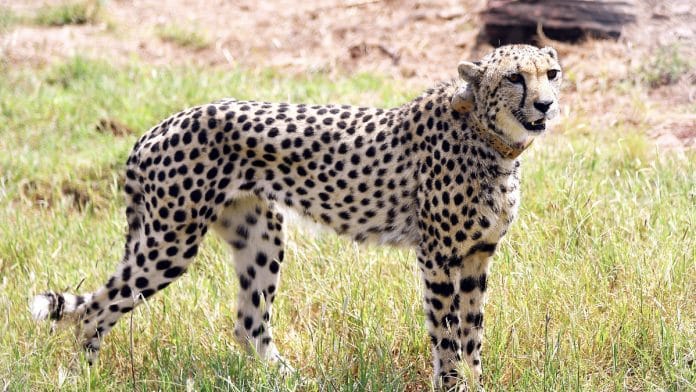New Delhi: Three weeks after their arrival, the newly translocated cheetahs from Namibia have acclimatised to their environment without any major hiccups, officials in Kuno National Park said.
“The cheetahs have adapted well, we haven’t faced any issues and they are healthy,” said Prakash Verma, Divisional Forest Officer at Kuno, adding, “At the moment they are still in quarantine.”
The cheetahs are in mandatory quarantine till October 17 — for one month — after which they are likely to be released into the 600 hectare enclosure built for them. Experts and officials are looking out for any signs of physical distress and illness through the quarantine period.
The translocation process could have long-term effects on the cheetahs, especially if the journey was stressful, wildlife veterinarian Dr Adrian Tordiffe had told ThePrint.
While most experts from the Cheetah Conservation Fund (CCF) — the Namibian organisation coordinating the translocation — have returned to their home country, Barthelemy Balli, the CCF’s Conservation Release Programme and Data Manager, continues to monitor the cheetahs in Kuno.
The challenges of the project are likely to mount once the cheetahs are out of quarantine and begin to hunt in earnest.
“The quarantine is likely to affect the fitness levels of the cheetahs, but they will gradually regain it as they begin to hunt,” said a wildlife conservationist involved with the translocation, who did not wish to be named, adding, “Our biggest concerns are losses to leopards and snaring and bush hunting.”
The translocation has proved controversial and divided conservationists across the world because of the many risks associated with the project. Once out of quarantine, the cheetahs’ survival will be challenged by a lack of space and competition with other big cats like leopards, conservationists have said.
The park is also being readied for 12 more cheetahs coming in from South Africa by building additional quarantine enclosures, said Field Director Uttam Kumar Sharma.
The Indian government has maintained that it is in the “advanced stages” of signing an agreement with South Africa to bring in the cats. When asked, Albi Modise, spokesperson for the Department of Forestry, Fisheries and Environment of South Africa told ThePrint, “The Department cannot comment on the MoU and related processes at this stage.”
Also Read: 70 years after they went extinct, cheetahs return to India in world’s largest conservation trial
Cheetah Task Force drops key player
The project ran into further controversy when Dr Y.V. Jhala, dean of Dehradun-based Wildlife Institute of India and an instrumental player in bringing the cheetahs to India, was dropped without any stated reason from a newly-formed panel to monitor the project.
On 22 September, the Ministry of Environment, Forest and Climate Change constituted a ‘Cheetah Task Force’ whose mandate is to “review, progress and monitor the health status of Cheetah, upkeep of the quarantine & soft release enclosures.”
The nine member task force, whose tenure is valid for two years, will also oversee the release of the cheetahs into the wild and come up with guidelines for tourism. Members include serving and former bureaucrats with the Madhya Pradesh government and forest officials from the National Tiger Conservation Authority.
Only one member, Dr Vishnupriya Kolipakam, a population geneticist at the Wildlife Institute of India, is a wildlife expert.
The newly-formed Cheetah Task Force is a body separate from the one created by a Supreme Court-appointed expert committee of which M.K. Ranjitsinh — veteran conservationist and former bureaucrat — is chairman. Ranjitsinh told The Indian Express that he had not been consulted or informed about the new panel.
Also Read: ‘Speed of a cheetah’ — read the subtext. Modi’s ‘pet’ project is heavy with political messaging
Cheetah mitra programme
With the arrival of the cheetahs, the state government launched an awareness campaign to prepare the nearby villages for a predator the region hasn’t seen in close to a century. Ambassador-volunteers, called ‘cheetah mitras (friends)’ were roped in from each village to spread awareness about the cheetah’s behaviours.
According to Bharat Singh Gurjar, a volunteer from Sesaipura village, the forest department hasn’t done enough outreach for the programme to be successful.
“We were roped in as cheetah mitras, but there has been barely any communication with the department since. There was one day of interaction, but not a lot of effort apart from that. We don’t know what’s happening inside the park or what to expect,” he said.
Field Director Sharma denied the claim, saying the department was consistently reaching out to villages through its forest rangers.
(Edited by Theres Sudeep)
Also Read: Memes, fake photos welcome cheetahs to India. Uttarakhand CM wasn’t welcomed by an elephant






